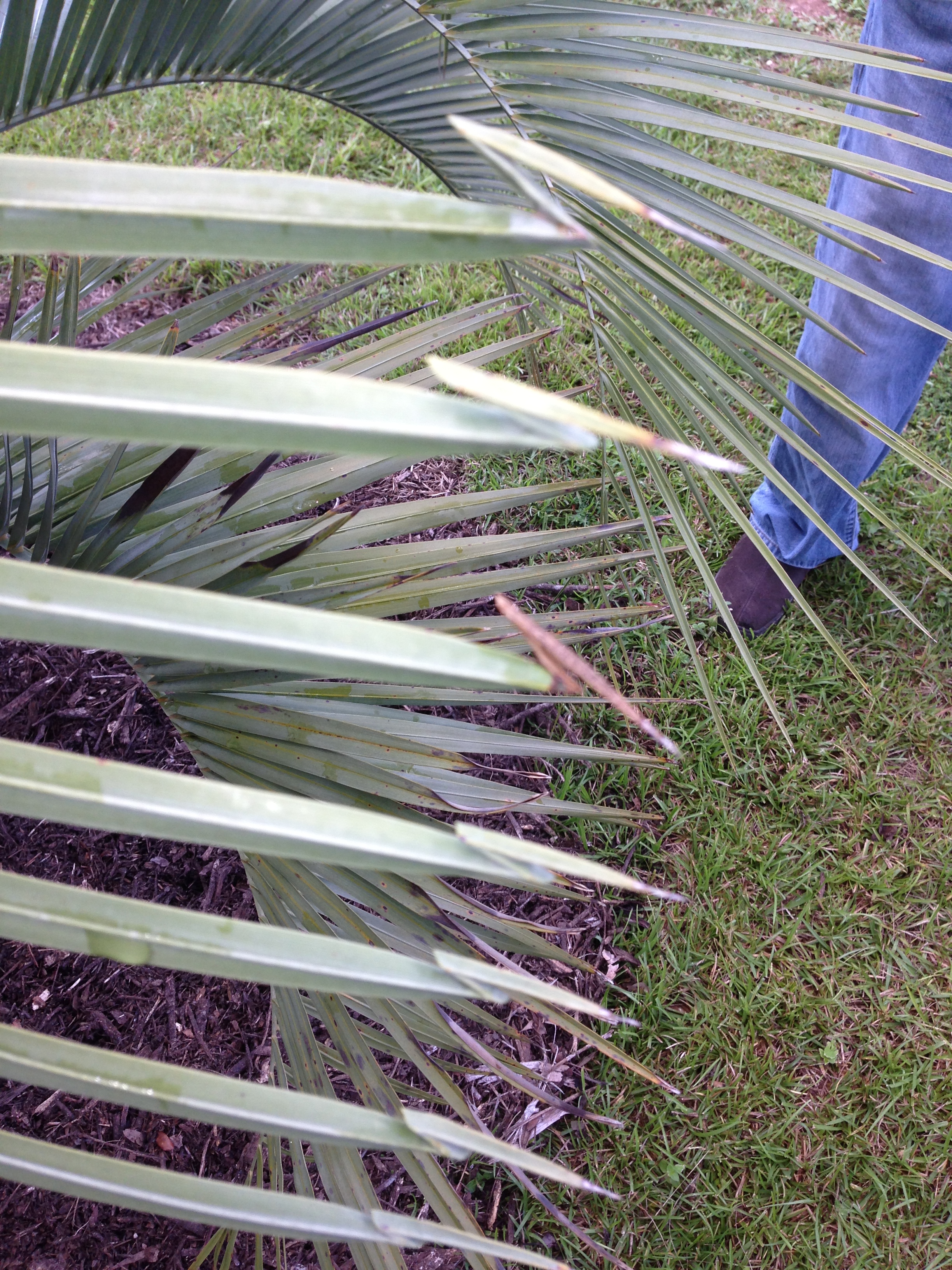
by Blake Thaxton | May 6, 2014
Palms can be difficult to manage in Northwest Florida. To have healthy palms it is important to think about possible cold temperatures, disease, and nutrient needs of palms. The panhandle of Florida was blasted with cold this winter and it is easy to see the effects on the palms. There are many palms throughout Northwest Florida which appear or are dead. This article will give information on several of the pesky palm problems observed throughout the region and some recommendations to help!
Cold damage is evident right now from this past winters’ very harsh temperatures. Some recommendations to help alleviate this problem include selection of the proper species. Some palms are not suited for colder temperatures and this must be taken in to account or you will continue to have problems even during mild winters. Look at the publication that has a table of palm suited for north Florida: Palms for North Florida
Next, develop a plan of action if your palm has been effected by cold damage. As has been seen throughout the panhandle, freeze damage can make an entire palm canopy turn brown and desiccate (dry out). It can even go as far as killing the spear leaf (The newly emerging palm leaf that resembles a spear). Even if the spear leaf has died and easily pulls out of the canopy, the palm may not be dead. If the meristem (the area of replicating cells that new leaves emerge from) survives the palm will also survive. If the spear leaf does die, give the palm 5-6 months to send out a new leaf before declaring it dead.
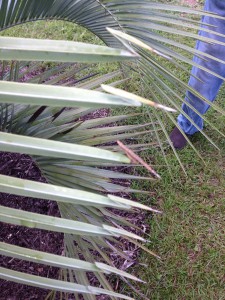
Hook-Leaf caused by an acute Boron deficiency
Another issue that may arise in the near future with the recent heavy rains is Boron deficiency of palms. Boron deficiency can be cause by leaching of soil Boron out of the root zone by heavy rain falls or heavy irrigation. When Boron has been leached from the soil it causes an acute (temporary) deficiency that will only last until microorganisms have time to break down more soil organic material that releases more Boron to the palm. Symptoms include small and crumpled new leaves, angular leaf tips, “hook-leaf”, and sometimes the stem bends sharply to one side. The symptoms won’t be visible for 4 to 5 months as the deficiency affects the leaf during development prior to its emergence. By the time it is seen the problem has probably already been corrected.
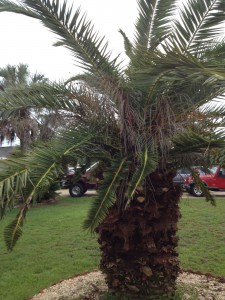
Chronic Boron Deficiency
Also, chronic (long-lasting) Boron deficiency problems can occur on palms. This deficiency is usually caused by soil drying and high soil pH. If there is a chronic Boron deficiency a drench can be applied to correct the problem. Learn more about Boron Deficiency of Palms
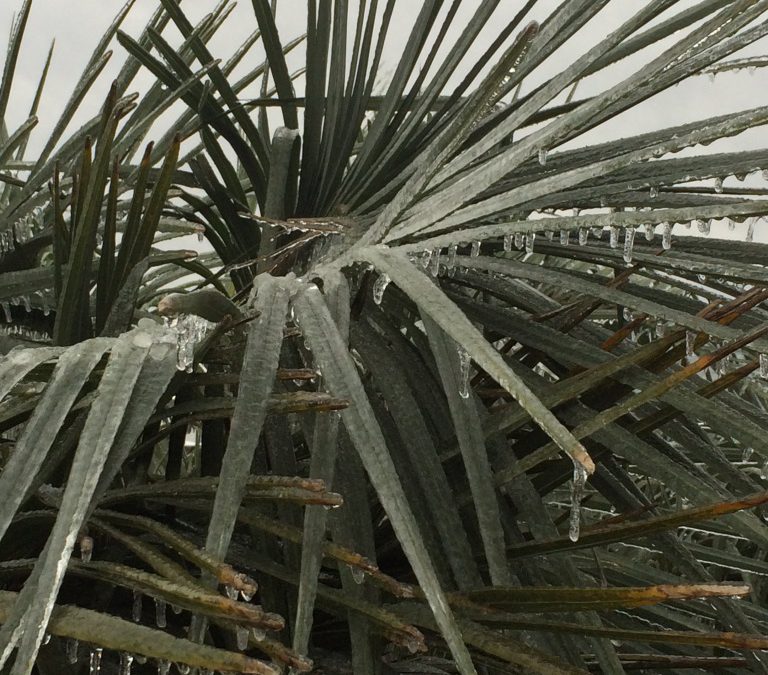
by Mary Salinas | Feb 4, 2014
The freezing rain last week across the panhandle left icicles hanging from street signs, rooftops, trees, shrubs and palms. Many people now wonder if their palms will survive the assault of the hard freeze. The chance of survival depends on the following factors:
- the most important consideration is the species of palm; a few of the most cold tolerant that are more readily available are pindo palm, mule palm, European fan palm, Chinese fan palm, needle palm, cabbage palm, and dwarf palmetto
- whether the palm is in an area protected by other vegetation or buildings
- proper fertilization with 8-2-12-4 has been followed
- palms have been properly pruned, i.e. only dead fronds have been removed from the crown (overtrimming by removing green fronds is a stress to the palm)
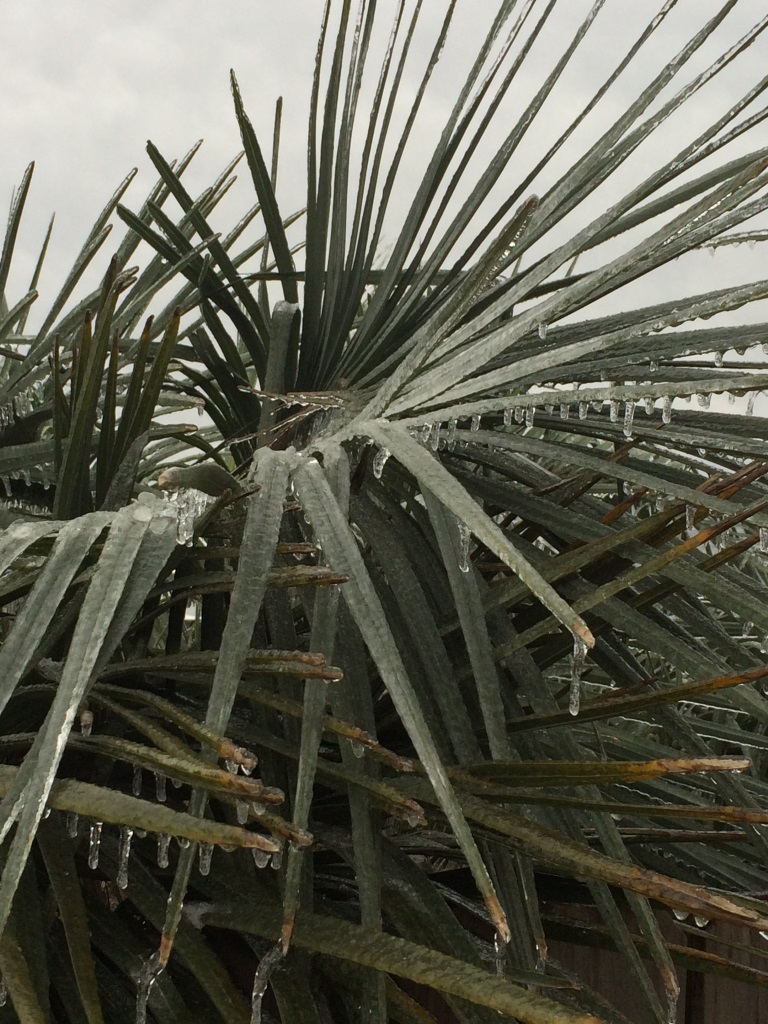
Icy pindo palm. Photo by Mary Derrick UF IFAS.
The best approach is to leave the palm alone until all danger of frost or freeze is past. Avoid the temptation to remove any of the dead fronds; they will help insulate and protect the meristem, or bud, that will produce new shoots.
If the palm is not too tall, in the spring check to see if the spear leaf (the newest frond that usually stands straight up and has not opened) can be easily pulled out. If the spear leaf does not pull out, the likelihood that the palm has survived is good. Don’t despair if the spear leaf does pull out as the meristem below it may still survive. The best strategy in that event is to remove the dead spear leaf and treat the bud area below the spear leaf with a copper fungicide to reduce the chance of infection of the bud. Be sure to use a copper fungicide and not a copper fertilizer, like copper sulfate.
Once spring comes and you find that the palms have survived, don’t be alarmed if the first new frond is deformed or has dead tips. The fronds that follow will most likely be normal. The palm will be building its depleted food reserves with new leaves so do not remove any fronds that have any green on them whatsoever. All green tissue is making food for the palm and helping it to recover from the cold stress. Only remove fronds that have completely died and have no green tissue.
When temperatures warm and the palms are actively growing, apply a palm fertilizer with the formulation of 8-2-12-4 with micronutrients.
For more information please see the following University of Florida IFAS publications:
Palms for North Florida
Cold Damage on Palms
Fertilization of Field-grown and Landscape Palms in Florida
Pruning Palms
by Mary Salinas | Nov 4, 2013
For centuries, people annoyed with plant pests have used oils to control insects, mites, and even some fungal diseases. Current oil products are better than ever!

Sample oil products for pest control. Photo by Mary Derrick.
Commercially available horticultural oils are mineral oils from refined petroleum products. Impurities are removed and then an emulsifying agent is added that allows the oil to mix with water for application. Neem oil is a newer product that has become increasingly popular; the oil is an extract of the seeds of the neem tree.
What are some of the advantages of using an oil for pest control?
- Oils are inexpensive and easy to apply
- Oils can be used on most plants (check the label for a list!)
- Oils control a wide range of pests that feed on plants (again, check the label for a list of pests the product will control!)
- Oils pose a low risk to people, pets, and desirable beneficial predators
- Since oils kill pests by blocking their breathing holes (spiracles) and/or gumming up their mouthparts, there is no chance for resistance to develop
- One product can control both insects and some diseases like powdery mildew at once
- Oils can be combined with some other pesticides to provide greater control
[warning] Don’t combine with, or use within 30 days of, any sulfur based pesticide. The combination can harm your plants![/warning]
There are always drawbacks to a product. What are the drawbacks?
- Some plants (including cryptomeria, junipers, cedars, maples, and redbud) are damaged by oils – check the label!
- Ensure good coverage during spraying as pests must be contacted with the oil in order for the control to work
- Oils break down quickly and reapplication may be necessary
- Check the label for instructions on the temperature range when it can be used. Older formulations generally are safe when temperatures are in the 40 to 80°F range but ultra-fine oils can generally be safely applied during hotter weather.
For further information:
Natural Products for Insect Pest Management from UF IFAS Extension
Insect Control: Horticultural Oils from Colorado State University Extension
Less Toxic Pesticides from Clemson University Cooperative Extension
by Mary Salinas | Sep 23, 2013
Is the newest growth on your sago palm turning yellow, brown, frizzy looking and dying – is it a pest or disease or something else?
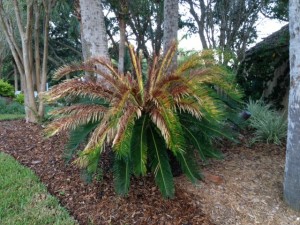
Photo credit: Mary Derrick
This sago palm is suffering from a classic case of manganese deficiency. When sago palms lack manganese, the newest leaves will develop yellow splotches or be entirely yellow. As the leaves die, they turn brown and take on a frizzled appearance. Sometimes the leaves or fruit may be smaller than normal. If left unchecked, the sago usually dies.
Manganese is a micronutrient required by all plants for normal, healthy growth and is most available for plant uptake when the soil pH is between 5.5 and 6.5. Soils in the Florida panhandle are often naturally low in manganese and then what available manganese is present can be unavailable for the plant to use if the pH of the soil is much above 6.5. Also, manganese tends to be leached from the soil when the pH is below 5.5. Soil pH and nutrient testing is useful to determine if soils are nutrient deficient. Contact your county Extension office for information on getting that done.
[notice]Before treating, rule out an infestation of Asian cycad scale. Click here for a UF IFAS Extension publication on this damaging insect. Be aware that both are common problems for sago palms and that your sago may be afflicted with both![/notice]
If this is happening to a sago palm, the good news is that it is easy to correct. Manganese sulfate is readily available at garden centers, feed &seed stores and independent nurseries. Just make sure to get manganese sulfate and don’t confuse it with magnesium sulfate (Epson salts). The amount of manganese sulfate necessary to correct this deficiency will vary with its size, soil type and pH. Sago palms in sandy, acidic soils require less manganese sulfate than those in high pH soils. One ounce is sufficient for a very small plant in sandy, acidic soil. A very large sago in a high pH soil may require about five pounds, however. Spread the product evenly over the root zone and water in with about a half inch of water.
The affected leaves cannot be cured but new growth should return to normal. If the new growth is still affected, an additional application of manganese sulfate may be needed. Once sago palms have suffered from a manganese deficiency, half the initial rate should be applied yearly to prevent the deficiency from re-occurring.
Even though sago palms are not true palms – they are cycads – their nutritional needs are very similar to palms. Most of the time they grow well without any supplemental fertilization, but if they do need fertilizing, use a 8-2-12-4 (the fourth number is magnesium) palm fertilizer with micronutrients and avoid using other fertilizer products in their root zones.
For more information on sago palms please see:
Cycas revoluta, Sago Palm
by Blake Thaxton | Mar 13, 2013
Many landscape managers and home owners, especially on the gulf coast, wants to add the tropical feel to their landscape. The chief way to achieve this is by incorporating Palms and other tropical plants to their surroundings. Like with any other plant one would like to care for it properly. The improper care of Palms, I would like to blame on simple lack of “know how” and nothing else. Some palm care practices are a real problem in Northwest Florida; whether it is pruning, installing, or fertilizing. University of Florida has some great resources available on Palm care and maintenance. Let’s hit some highlights and use these tips to improve Palm care in northwest Florida.

First, installation is very important with Palms, as it is with all plants. One practice that ultimately results in death to a Palm is planting too deeply. Some have done this in the past to help secure the Palm from falling over. This may seem like a good idea but will harm the plant in many ways. Look at these two palms that were planted at the same time, see the difference?

Make sure when your planting to dig the hole twice as wide as the rootball and only as deep as the rootball is tall. Then for support build a supporting structure, but do not nail directly into the trunk (this will allow an entry point for disease). Once planted, water the palm in thoroughly, allowing for all the air pockets to be compromised If the fronds are tied up, untie them as soon as your palm is planted.

The next issue that faces palm lovers is pruning palms. Many prune a palm too much for a variety of reasons. Take a look at this palm for an example of a palm that has been pruned too much.

Follow the 9 to 3 clock rule, only pruning above the horizontal line of the crown of the palm. If you follow this rule you will generally be pruning correctly.

Read more about pruning, installing and general palm information for northwest Florida.
Photo Credits, University of Florida.












